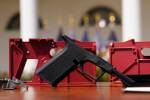Hunting tragedies show need for safety refresher
Statistically speaking, hunting is near the top of the list when it comes to safest recreational pursuits. According to a report by the National Shooting Sports Foundation, hunting with firearms holds the third position on the top 10 list of safest activities, right between the high-adrenaline sports of billiards and bowling.
Camping has a tight grasp on the No. 1 spot.
When it comes to hunting with firearms, the percentage of injuries per 100 participants is 0.04 percent. That figure includes accidents involving the use of tree stands.
Rounding out the top 10 list in order of appearance are running/jogging, target archery, tennis, mountain biking, water skiing and golf. Golf's injury rate is 0.16 percent.
Baseball, on the other hand, has an injury rate of 1.26 percent per 100 participants. For bicycle riding, basketball and tackle football, it is 1.38, 2.06 and 5.2 percent. You get the picture.
Unfortunately, when an activity is generally quite safe, its participants can become complacent, and it sometimes takes an unfortunate incident or two to remind us of the importance of following the basic safety rules.
During October, two hunters died as a result of firearms-related accidents in the Intermountain West. Both involved the accidental discharge of a firearm.
The first took place Oct. 2 in the O'Neil Basin area north of Elko, when Stephen James Foley, 48, of Carson City was accidentally shot when his hunting partner placed a firearm in the rear seat of their vehicle. The ensuing investigation showed that the shooter had removed the rifle's magazine but failed to clear the chamber.
It was Nevada's first fatal hunting accident since 1997. Before that, there had been 25 fatal hunting accidents in Nevada since 1955.
About a week later, Zachary Woodruff, 10, of Smithfield, Utah, was killed when the firearm a family friend was removing from an ATV accidentally discharged and the bullet struck the boy. The accident took place during a family hunting trip in northern Utah.
Incidents such as these are devastating, not only for the victims' families but also for the person who was handling the firearm when it accidentally discharged. Everyone involved will carry the scars for the rest of their lives.
These incidents also are a reminder that the tools we use when hunting must be handled with great care. Once a firearm is discharged, we can't call the bullet or shot back. Accident prevention begins with the four primary rules of safe gun handling that are taught during the state-mandated Hunter Education course.
First, always point the firearm's muzzle in a safe direction. For obvious reasons, nothing is more disconcerting to an experienced shooter than having another hunter or shooter cover them with the muzzle of a firearm. Proper muzzle control requires constant vigilance and mature decision-making to keep the muzzle pointed in a safe direction.
Second, treat every gun as if it were loaded. Even if you know it is unloaded. By treating every firearm with the respect due a loaded gun, we never will be tempted to do something that might accidentally hurt ourselves or someone else.
Third, keep your finger off the trigger until you are ready to shoot your intended target. Walking around with your finger on the trigger is an accident just waiting to happen. The trigger isn't going anywhere. You always will be able to find it when the appropriate time comes.
And fourth, be sure of your target and what is beyond it. Take the time to properly identify your intended target and keep in mind that when you are hunting, someone else is, too. Also, you want to make sure you have a good backstop behind your target in case of a pass through or a miss.
Most firearms-related accidents are caused when someone violates one of these four basic rules. Be sure to keep them in mind whenever you are around a firearm and be sure those who are with you do the same. And don't be afraid to correct someone when they forget to follow them. That is not the time to keep your mouth shut.
Freelance writer Doug Nielsen is a conservation educator for the Nevada Department of Wildlife. His "In the Outdoors" column, published Thursday in the Las Vegas Review-Journal, is not affiliated with or endorsed by the NDOW. Any opinions he states in his column are his own. He can be reached at intheoutdoorslv@gmail.com.




























